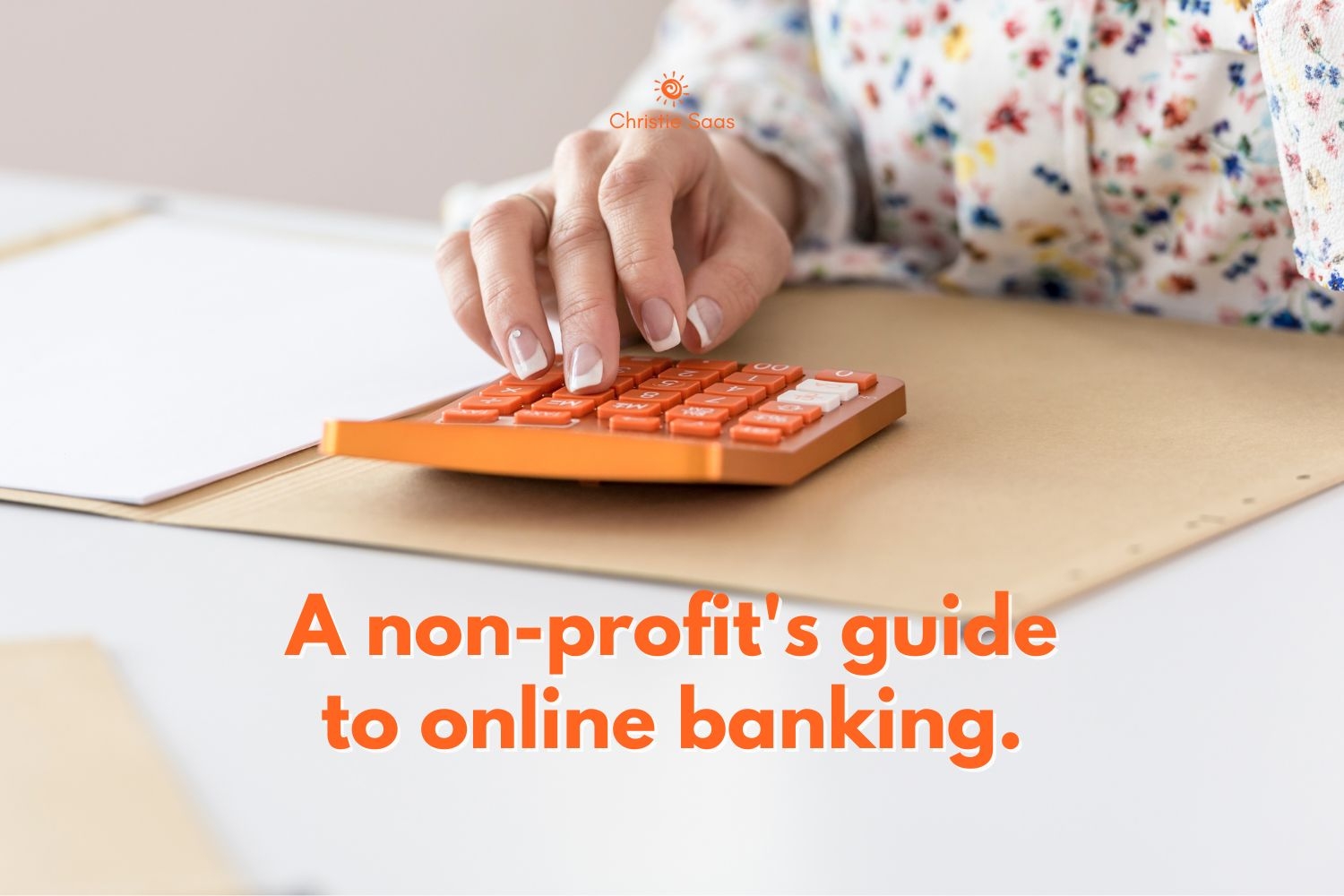A non-profit's guide to online banking

Non-profits have many reasons to embrace online banking (e-banking). It might start with a desire to make faster payments to independent contractors, to encourage easier donations, or simply avoid the time it takes for in-person banking.
When an executive director begins to investigate the possibility of online banking, it becomes very clear that digital transactions might be a little more challenging when following the standard non-profit two-signature policy for cash management.
Slow is safer, but still slow.
The two-signature policy is a risk management tool meant to reduce chances of fraud. Having a second signer means there is a second set of eyes reviewing each transaction, ensuring it is legitimate, and all supporting documentation is in place.
Having a second signer is also extremely slow and often frustrating.
Before giving up hope that you will be stuck in the ‘waiting 3 weeks for a second signature on a cheque’ payment agony, please feel reassured that there are ways to make the switch to online banking a reality. It is going to take some research, some work, and maybe even a little creative policy development, but it can be done.
Review existing policies.
Begin by finding your organization’s signing policy, usually included in the executive limitations. You are looking for what’s written about having two signatures on financial transactions.
- Look for a policy that notes if two signatures are required for ALL financial transactions.
- If so, are they required BEFORE each transaction, or are some allowed AFTER a transaction occurs?
- Look for any policies that have different double-signer rules, such as for cheques vs. for credit card purchases.
- Usually double-signature policies are applied to payments but also look for anything written in policy to determine when a double signature is required for deposits.
- Note the policy details in a research document.
Remember, you are gathering information about your organization’s existing rules. You are not deciding anything just yet.
Make an appointment to talk to your bank rep.
Call your bank rep to ask some questions about what requirements the bank has on file for your non-profit. Like the previous policy review step, this is to gather information only. You are not deciding anything. Ask these questions.
- Our organization is considering using online banking and I am gathering information about a variety of options.
- Before I jump into the details, I’d like to confirm details about our current/traditional banking procedures.
- What is the number of signers [name of bank] requires on traditional cheque payments for our account?
- What does [name of bank] do if a cheque come in with only one signature and our account requires two?
- Does [name of bank] allow anyone to make a deposit to our account if they have the account number and correct forms?
Then move on to learning about the bank’s full suite of online banking options, and how each might be different for one signer or two signers. Ask these questions.
- What digital payment options does [name of bank] offer for online bill payment system vs. e-transfer payments?
- What would my organization need to do/change to be set-up to use online bill payments and/or e-transfer payments?
- Would that be any different for a single signer vs. a double signer account?
- Does [name of bank] have a built-in platform that supports online banking using a double signer system?
- Can I see a demo of how the online double-signer system works?
Finally, learn the process for receiving e-transfer deposits. Ask these questions.
- What would my organization need to do/change to be set-up to receive e-transfer deposits?
- Would that be any different for a single signer vs. a double signer account?
Record all the details you learned from your bank rep, in your research document, noting specific details about the number of signers.
I’m presuming.
I’m presuming that your non-profit is already set-up with online access to view bank transactions and print statements. If you are starting completely from scratch, you will need to spend a little more time talking to your bank representative about how to get set-up with the basics.
Don’t stress if you aren’t set-up for online account access. For many non-profits, any type of online banking can feel very scary. Take your time!
Write a ‘bugs me’ list.
With all the information you have gathered, its time to decide how you would like your organization’s cash management to be different. I usually approach this step by making a private little list of the things that bug me. Here are a few examples.
- It takes 3+ weeks to get a second signature on cheques. Payments are delayed and late fees happen frequently.
- Clients ask repeatedly if they can pay fees by e-transfer.
- It takes too long to reimburse employees for travel expenses.
- Receiving donations is cumbersome and sometime annoys donors.
- Etc.
Weigh the options.
Now you need to draft a plan to make the changes you desire.
All the options will need to be weighed to determine the best fit for your non-profit. Knowing what policies are currently in place (your research) and what procedures aren’t working (your ‘bugs me’ list), will help to determine what kind of online banking changes should be considered.
I wish there was a simple playbook I could give you here, but every non-profit is different… and that is a GOOD thing. You will need to draft the best plan for your organization.
- Some non-profits will want full double-signer control over all online banking transactions and will take the time to train everyone on the bank’s two-step authorization system.
- Some non-profits will revise bank-account set-up to allow for one person to handle online banking.
- Some non-profits will already be set-up for single-signer transactions and monitor everything with two signers at the review stage. So, the progression to single-signer online banking might be very easy.
- Some non-profits will opt for a hybrid system that requires certain types of financial transactions to use traditional cash management procedures and allows other types of financial transactions to use online banking.
- Some non-profits won’t want to make online payments at all and will only want to receive online deposits.
- Some non-profits will feel the risk of any type of online banking is simply too high and will opt to stick with very traditional payment and deposit systems.
Write your proposal.
The final step is to write out a proposal for online banking, that will be taken to the board for approval. The proposal needs to include a summary of your research, the rationale, the risks involved, and suggested wording for policy changes.
Policy is key for changes to cash management systems. It is one of the key places a non-profit’s auditor is going to look when evaluating the financial files. Are you following your own policies?
A non-profit that has cash management systems that are not recorded in policy is at risk of not only fraud, but also irreversible mistakes, and notations on audit documentation that might jeopardize funding.
Plan. Test. Evaluate. Revise.
Non-profits shouldn’t be afraid to build in a trial period for online banking changes to cash management systems. Sometimes the system doesn’t work the way everyone hoped, and revisions are needed. Sometimes the policy doesn’t quite capture the full details.
Monitoring and revising are a great way to ensure you have the right policy and the right system.
With board approval and a fresh policy in hand, an executive director can begin to embrace the convenience of online banking while doing their best to avoid all the pitfalls.
Your turn.
Your turn. Does your non-profit use online banking? Are your accounts single-signer or double-signer? Do you have policies to support your systems? I want to know! Please use the form on the side of the page to let me know, ..or send me an email, ..or message me on socials.
-Christie
…
Hi, I'm Christie. I help executive directors develop the systems and processes needed to run a non-profit.
I learned early in my career, there is no non-profit school. Browsing the internet for resources from big-city experts doesn’t provide practical solutions to balance the budget, write a work plan, or conduct an employee evaluation. Leadership development tips don’t really resonate when you are also taking out the recycling and cleaning the washroom.
I created ChristieSaas.com so non-profit leaders never need to wonder how to do the job – no matter how big or small that job is.
I have been the executive director of small-team, small-budget, non-profits for 20+ years. My experience isn’t theory. It is the real, operational, and practical solutions I use every day.
I love my work and I want to help you love yours too.
© Christie Saas 2023 All Rights Reserved
…
Want to learn more?
Start with one of my free resources.


